FORAM FACTS — AN
INTRODUCTION TO FORAMINIFERA
KAREN WETMORE
Foraminifera (forams for short) are single-celled organisms (protists) with shells or tests (a
technical term for internal shells). They are abundant as fossils for the last 540 million years.
The shells are commonly divided into chambers that are added during growth, though the
simplest forms are open tubes or hollow spheres. Depending on the species, the shell may be
made of organic compounds, sand grains or other particles cemented together, or crystalline
CaCO3 (calcite or aragonite).
Fully grown individuals range in size from about 100 micrometers to almost 20 centimeters
long. Some have a symbiotic relationship with algae, which they "farm" inside their shells.
Other species eat foods ranging from dissolved organic molecules, bacteria, diatoms and
other single-celled algae, to small animals such as copepods. They catch their food with a
network of thin pseudopodia (called reticulopodia) that extend from one or more apertures in
the shell. Benthic (bottom-dwelling) foraminifera also use their pseudopodia for locomotion.
WHERE DO THEY LIVE?
There are an estimated 4,000 species living in the world's oceans today. Of these, 40 species
are planktonic, that is they float in the water. The remainder live on or in the sand, mud, rocks
and plants at the bottom of the ocean. Foraminifera are found in all marine environments,
from the intertidal to the deepest ocean trenches, and from the tropics to the poles, but species
of foraminifera can be very particular about the environmentin which they live. Some are
abundant only in the deep ocean, others are found only on coral reefs, and still other species
live only in brackish estuaries or intertidal salt marshes.
Foraminifera are among the most abundant shelled organisms in many marine environments.
A cubic centimeter of sediment may hold hundreds of living individuals, and many more
dead shells. In some environments their shells are an important component of the sediment.
For example, the pink sands of some Bermuda beaches get much of their color from the pink
to red-colored shells of a foraminiferan. In regions of the deep ocean far from land the bottom
is often made up almost entirely of the shells of planktonic species.
WHY ARE THEY IMPORTANT?
The study of fossil foraminifera has many applications beyond expanding our knowledge of
the diversity of life. Fossil foraminifera are useful in biostratigraphy, paleoecology,
paleobiogeography, and oil exploration.
 Return to top Return to top
BIOSTRATIGRAPHY
Foraminifera provide evidence of the relative ages of marine rocks
There are several resons that fossil foraminifera are especially valuable for determining the
relative ages of marine rock layers. They have been around since the Cambrian, over 500
million years ago. They show fairly continuous evolutionary development, so different
species are found at different times. Forams are abundant and widespread, being found in all
marine environments. Finally, they are small and easy to collect, even from deep oil wells.
PALEOECOLOGY AND PALEOBIOGEOGRAPHY
Foraminifera provide evidence about past environments
Because different species of foraminifera are found in different environments, paleontologists
can use the fossils to determine environments in the past. Foraminifera have been used to
map past distributions of the tropics, locate ancient shorelines, and track global ocean
temperature changes during the ice ages. If a sample of fossil foraminifera contains many
extant species, the present-day distribution of those species can be used to infer the
environment at that site when the fossils were alive. If samples contain all or mostly extinct
species, there are still numerous clues that can be used to infer past environments. These
include species diversity, the relative numbers of planktonic and benthic species, the ratios of
different shell types, and shell chemistry.
The chemistry of the shell is useful because it reflects the chemistry of the water in which it
grew. For example, the ratio of stable oxygen isotopes depends on the water temperature,
because warmer water tends to evaporate off more of the lighter isotopes. Measurement of
stable oxygen isotopes in planktonic and benthic foram shells from hundreds of deep-sea
cores worldwide have been used to map past surface and bottom water temperatures. This
data helps us understand how climate and ocean currents have changed in the past and may
change in the future.
OIL EXPLORATION
Foraminifera are used to find petroleum
Some species are geologically short-lived and some forms are only found in specific
environments. Therefore, a paleontologist can examine the specimens in a small rock sample
like those recovered during the drilling of oil wells and determine the geologic age and
environment when the rock formed. As a result, since the 1920's the oil industry has been an
important employer of paleontologists who specialize in these microscopic fossils.
Stratigraphic control using foraminifera is so precise that these fossils are even used to direct
sideways drilling within an oil-bearing horizon to increase well productivity.
BIOLOGY OF FORAMINIFERA
Very little is known about how most species of foraminifera live. The few species that have
been studied show a wide range of behaviors, diet, and life cycles. Individuals of some
species live only a few weeks, while other species live many years. Some benthic species
burrow actively, though slowly, through sediment at speeds up to 1cm per hour, while others
attach themselves to the surface of rocks or marine plants. Foraminifera are abundant enough
to be an important part of the marine food chain, and their predators include marine snails,
sand dollars and small fish.
 Return to top Return to top
CLASSIFICATION OF FORAMINIFERA
Traditionally, classification of foraminifera has been based primarily on characters of the
shell or test. Wall composition and structure, chamber shape and arrangement, the shape and
position of any apertures, surface ornamentation, and other morphologic features of the shell
are all used to define taxonomic groups of foraminifera. New research is adding molecular
data on relationships among species that may greatly affect how these organisms are
classified.
Chamber arrangements commonly found in living species are shown in figures 1-6. The
following terms are used: Unilocular refers to a shell made of a single chamber Uniserial
refers to chambers added in a single linear series Biserial refers to chambers added in a
double linear series Triserial refers to chambers added in a triple linear series Planispiral
refers to chambers added in a coil within a single plane like the chambered nautilus
Trochospiral refers to chambers added in a coil that forms a spire like a snail shell Milioline
refers to an arrangement where each chamber stretches the full length of the shell and each
successive chamber is placed at an angle of up to 180 degrees from the previous, relative to
the central axis of the shell Arborescent refers to an erect, branching series of tubes. Terms
such as planispiral-to-biserial and biserial-to-uniserial are used when the mode of chamber
addition changes during growth.
Of the various kinds of wall composition and microstructure found in foraminifera, three
basic types are common among living species. Agglutinated shells may be composed of very
small particles cemented together and have a very smooth surface, or may be made of larger
particles and have a rough surface. Hyaline shells are made of interlocking microcrystals of
CaCO3, and typically have a glassy appearance and pores that penetrate the wall.
Porcelaneous shell walls are composed of microscopic rod-shaped crystals of CaCO3. These
have a milky, translucent to opaque look and generally lack pores beyond the initial
chambers. In some porcelaneous species, small depressions in the surface ornamentation give
the appearance of pores. Another type of wall structure, called microgranular, is made of
tightly packed equidimensional rounded grains of calcite. This wall type is found in many
Paleozoic foraminifera including the fusulinids.
Figures 1-6. These images were captured using the Environmental Scanning Electron Microscope at the UC Museum of Paleontology, Berkeley, CA.
|
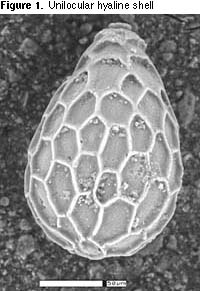
 Return to top
Return to top
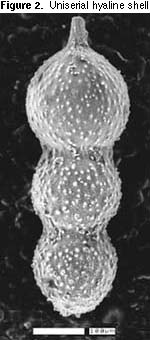
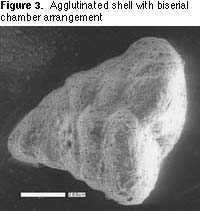
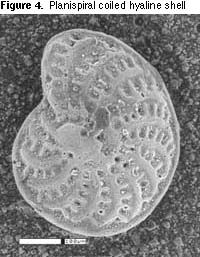
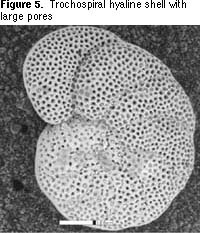
 Return to top
Return to top
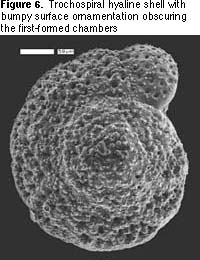

 Return to top
Return to top




 Return to top
Return to top
